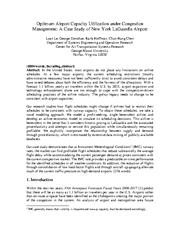A copy of this work was available on the public web and has been preserved in the Wayback Machine. The capture dates from 2017; you can also visit the original URL.
The file type is application/pdf.
Optimum Airport Capacity Utilization under Congestion Management: A Case Study of New York LaGuardia Airport
2008
Transportation planning and technology (Print)
4804 words, including abstract) Abstract. In the United States, most airports do not place any limitations on airline schedules. At a few major airports, the current scheduling restrictions (mostly administrative measures) have not been sufficiently strict to avoid consistent delays and have raised debates about both the efficiency and the fairness of the allocations. With a forecast 1.1 billion yearly air travelers within the U.S. by 2015, airport expansion and technology enhancement alone are
doi:10.1080/03081060701835779
fatcat:5sdvmrfe5zcxxnii4e7ibre5qa

